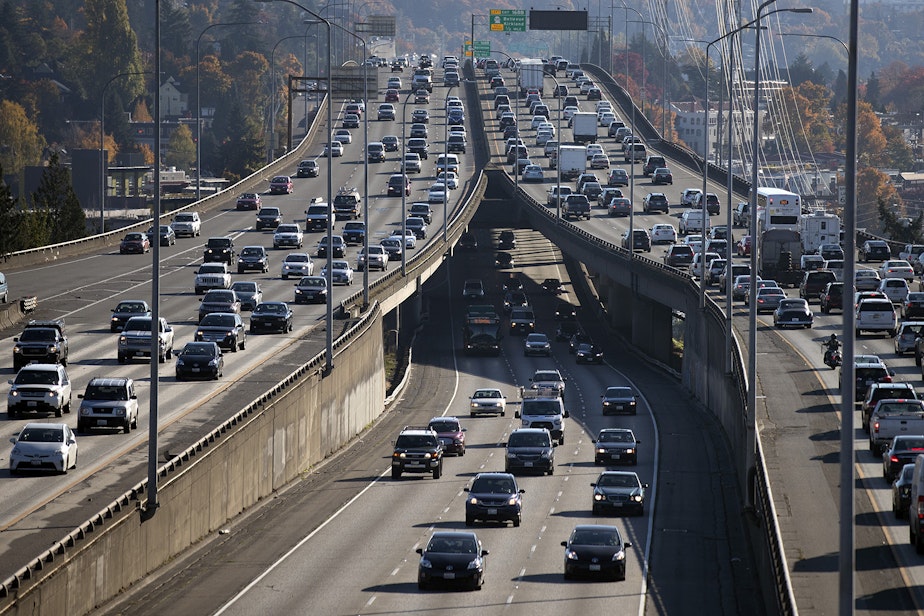I drove like a jerk in Seattle traffic to see if it would save me time

It was 8:30 a.m., and I was crawling south on Interstate 5 in gummy Seattle commuter traffic.
I was making this drive in the name of journalism, to answer a question from a listener, Mariah St. Clair, who had contacted KUOW with a seemingly simple question: Is weaving between lanes in heavy traffic worth it?
Before heading into this muck, though, I called the experts. Canadian science researcher Dr. Donald Redelmeier has studied traffic weaving, and according to his research, it’s definitely not worth it. Turns out humans are terrible at judging which lane is moving faster.
"Under congested roadways, our own eyes start to play tricks on us,” he said. “It makes it seem that the next lane is going faster than the lane we're in right now, even though all the lanes have the same average speed.”
To study this, Redelmeier had subjects look at computer simulations. Most said they believed the next lane over was moving faster, even though it wasn’t. Asking real drivers to change lanes on a real highway would be unethical, he said, hence the simulation.
Which is how I ended up in sticky Seattle traffic, a lone guinea pig for my own experiment.
It was more emotional than I expected. Weaving produced in me waves of fear, desperation — and a distinctly uncomfortable Seattle feeling that comes from driving like a jerk, even if it is for science.
Now. Obviously you sometimes have to weave.
“You'd be a bozo not to,” Redelmeier said. The problem is that drivers overestimate the benefits of changing lanes, and that puts you and everyone else on the highway at risk. When you change lanes, you're roughly three times as likely to get into an accident compared with staying in your lane, Redelmeier said.

So it’s risky and it's stupid. But is it faster?
Mark Hallenbeck, a traffic expert at the University of Washington, said no traffic engineer has studied that question. But he did have a lot to say about why traffic engineers hate traffic weaving.
"Weaving is disruptive, disruption reduces efficiency, and reductions in efficiency cause congestion. So we don't like weaving," Hallenbeck said.
Me: “Okay, it's bad and you don't like it, but can you get there faster?”
Hallenbeck: “Traffic engineers don’t care."
But Hallenbeck admitted that sometimes you might get there a little faster by weaving, especially if you're willing to be a jerk.
For our highway experiment, Mariah St. Clair picked a lane and stuck with it. I would be the weaver.
Mariah St. Clair got a one-car head start, and sticks with her usual commuting strategy. "I like to stay in this lane so that mostly I just can keep going,” she said. "It's kind of slow, and steady wins the race is my plan."
Out the gate, I changed lanes four times. When I looked in the rearview mirror, a man in a blue Prius shook his head at me. He made a weaving motion with his hand, like a fish swimming in the water.
I got my first driver's license on the East Coast, but I burned with Seattle shame.
After weaving in and out traffic for several minutes, I found myself behind Mariah St. Clair. Ashamed and losing.
Finishing up this experiment, I drove to Mariah St. Clair’s parking garage, our meeting spot. I expected to see her there, waiting smugly.
She was not there, however. She arrived less than a minute later, which meant I was triumphant. I had won!
Then I remembered: I had driven like a jerk. A Prius driver had rolled his eyes at me. And, per the experts, I had put myself and others at risk.
And the shame. Oh, the shame.
Anna Boiko-Weyrauch contributed to this story.

